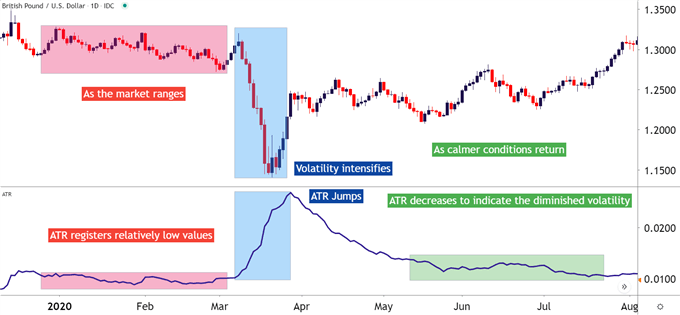MEASURING VOLATILITY: TALKING POINTS
- Volatility is the measurement of price variations over a specified period of time.
- We discuss the Average True Range indicator (ATR) as a measurement of volatility.
Technical Analysis can bring a significant amount of value to a trader.
While no indicator or set of indicators will perfectly predict the future, traders can use historical price movements to get an idea for what may happen in the future.
In this article, we’re going to take the discussion of technical analysis a step further by focusing on one of the primary factors of importance in determining market conditions: Volatility.
THE RISK OF VOLATILITY
The allure of high-volatility conditions can be obvious: Higher levels of volatility mean larger price movements, and larger price movements mean more potential opportunity but also more possible risk.
Traders need to see the full spectrum of this scenario: Higher levels of volatility also mean that price movements are even less predictable. Reversals can be more aggressive, and if a trader finds themselves on the wrong side of the move, the potential loss can be even higher in a high-volatility environment as the increased activity can entail larger price movements against the trader as well as in their favor.
AVERAGE TRUE RANGE
The Average True Range indicator stands above most others when it comes to the measurement of volatility. ATR was created by J. Welles Wilder (the same gentlemen that created RSI, Parabolic SAR, and the ADX indicator), and is designed to measure the True Range over a specified period of time.
True Range is specified as the greater of:
- High of the current period less the low of the current period
- The high of the current period less the previous period’s closing value
- The low of the current period less the previous period’s closing value
Because we’re trying to measure volatility, absolute values are used in the above computations to determine the ‘true range.’ So the largest of the above three numbers is the ‘true range,’ regardless of whether the value was negative or not.
Once these values are computed, they can be averaged over a period of time to smooth out the near-term fluctuations (14 periods is common). The result is Average True Range.
In the chart below, we’ve added ATR to illustrate how the indicator will register larger values as the range of price movements increases:
GBP/USD (Jan-Aug 2020) with ATR Applied

Prepared by James Stanley in TradingView
HOW TO USE ATR
After traders have learned to measure volatility, they can then look to integrate the ATR indicator into their approaches in one of two ways.
- As a volatility filter to determine which strategy or approach to employ
- To measure risk outlay, or possible stop distance when initiating trading positions
USING ATR AS A VOLATILITY FILTER
Traders can approach low-volatility environments with one of two different approaches.
Simply, traders can look for the low-volatility environment to continue, or they can look for it to change. Meaning, traders can approach low-volatility by trading the range (continuation of low-volatility), or they can look to trade the breakout (increase in volatility).
The difference between the two conditions is huge; as range-traders are looking to sell resistance and buy support while breakout traders are looking to do the exact opposite.
Further, range-traders usually have the luxury of well-defined support and resistance for stop placement; while breakout traders do not. And while breakouts can potentially lead to huge moves, the probability of success is significantly lower. This means that false breakouts can be abundant, and trading the breakout often requires more aggressive risk-reward ratios (to offset the lower probability of success).
USING ATR FOR RISK MANAGEMENT
One of the primary struggles for new traders is learning where to place the protective stop when initiating new positions. ATR can help with this goal.
Because ATR is based on price movements in the market, the indicator will grow along with volatility. This enables the trader to use wider stops in more volatile markets, or tighter stops in lower-volatility environments.
The ATR indicator is displayed in the same price format as the currency pair. So, a value of ‘.00458’ on EUR/USD would denote 45.8 pips. Alternatively, a reading of ‘.455’ on USDJPY would denote 45.5 pips. As volatility increases or decreases, these statistics will increase or decrease as well.
Traders can use this to their advantage by placing stops based on the value of ATR; whether that be a factor of the indicator (such as 50% of ATR) or the direct indicator read itself. The key here is that the indicator read would be responsive to recent market conditions, allowing for an element of adaptation by the trader employing the indicator in their approach.
If you’d like to access the ATR indicator, it’s available in the suite of indicators on IG trading platforms, demos included. Click here to request a free demo with IG group.

 Signal2forex.com - Best Forex robots and signals
Signal2forex.com - Best Forex robots and signals




